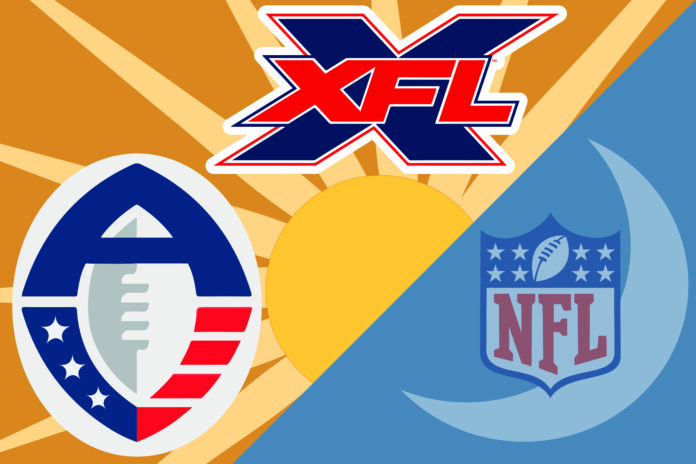Examining the newest football league and what it means for the NFL
If one thing is for certain, it’s that the NFL is the world’s most popular football league. Since the AFL-NFL merger in 1966, other aspiring professional football leagues have come and gone, but the NFL has remained. Arguably its biggest rival was the United States Football League in 1983, but even the USFL only lasted three years before it fell apart. While past leagues have tried and failed to compete with the NFL, the Alliance of American Football seems to be taking a different route that shows it has learned from the past failures of others.
So what is the AAF? It’s a new football league that began its inaugural season a week after Super Bowl 53 and runs through the end of April. It aims to give players a second (or first) chance at professional football and to eventually make it into the NFL. It was founded by television and film producer Charlie Ebersol and former NFL executive Bill Polian.
The league is made up of many former college football stars whose professional careers fizzled out. Notable players include Trent Richardson, Christian Hackenberg, Josh Johnson and Zac Stacy, all of whom are looking to get back into the league.
Familiar coaches include former South Carolina Head Coach Steve Spurrier, former 49ers Head Coach Mike Singletary and Pac-12 journeyman Rick Neuheisel. Retired NFL legends including Jared Allen, Hines Ward and Troy Polamalu are members of the league’s leadership board.
The player contracts are worth $250,000 over three years and include other incentives and benefits, such as player health insurance. The contracts also allow players to move on to the NFL if such an opportunity arises. This salary pales in comparison to NFL salaries but is still generous considering AAF players only work four months out of the year.
The league is comprised of eight teams, most of which are located in cities that do not have a professional football team. The reason behind this is to build a fanbase without having to worry about competition with other pro franchises nearby. Cities like San Antonio, Birmingham and Salt Lake have long wanted to have a professional football team and now host AAF clubs.
Outside of Atlanta and Arizona, the markets for football are favorable for the AAF. A matchup in week two where the Orlando Apollos traveled to San Antonio to face the Commanders had a total attendance of 29,176. Another game in San Diego saw an attendance of 20,000. Although it’s early, these initial signs are encouraging.
Not only are people showing up to the game, but they are tuning in to watch as well. In the first week of action, the AAF had more viewers (2.91 million) than the NBA Saturday night game (2.38 million) between the Houston Rockets and the Oklahoma City Thunder. AAF games also have limited commercial breaks compared to those of the NFL and aim to run about 30 minutes less than an average NFL game.
The AAF rules are similar to the NFL rules with a few differences. There are no kickoffs, as teams always start at the 25-yard line after any score. There are also no extra points, as teams must go for two after every touchdown. The most drastic change, however, is with the overtime rules. Each team has one possession from the 10-yard line and four downs to score with no field goals allowed. If neither team scores, the game ends in a tie.
In week one, the AAF was trending on Twitter, specifically due to a big hit on San Diego’s quarterback Mike Bercovici. The video of the hit has been shared millions of times and seemed to catch the attention of many people online. The AAF is also catching the attention of gamblers, as the league has already allowed the public to place bets on games and interact with a unique fantasy-style game platform.
Ultimately, the goal of the AAF is not to overtake the NFL but to work alongside it.
“We really felt it was important to be in a symbiotic relationship with [the players] and complementary to the NFL,” Ebersol told Business Insider in February.
Although leagues like the USFL and XFL failed, the AAF is making a conscious effort to try and avoid the mistakes that past leagues made. Although the AAF and the NFL don’t have an official partnership, there is no antipathy between them either. Some AAF games are even set to air on the NFL Network.
In the long run, there appears to be potential benefits to both sides. The NFL does not have a minor league system where they can develop players like the other major sports leagues do, such as the NBA, MLB and NHL. Not only does a minor-league system have the potential to develop young players, but it would also help the AAF capture the interest of NFL fans looking at possible future players.
The AAF knows that historically speaking, it does not have a chance in a head-to-head battle with the NFL, so trying to work with the NFL has the potential to keep the AAF alive. In a league where millions of fans dread the long, brutal offseason without football, this alternative might be what the NFL and its fans need.
Written by: Omar Navarro — sports@theaggie.org





